Kakidan ekotoba monster scroll Stock Photos and Images
(20)See kakidan ekotoba monster scroll stock video clipsKakidan ekotoba monster scroll Stock Photos and Images
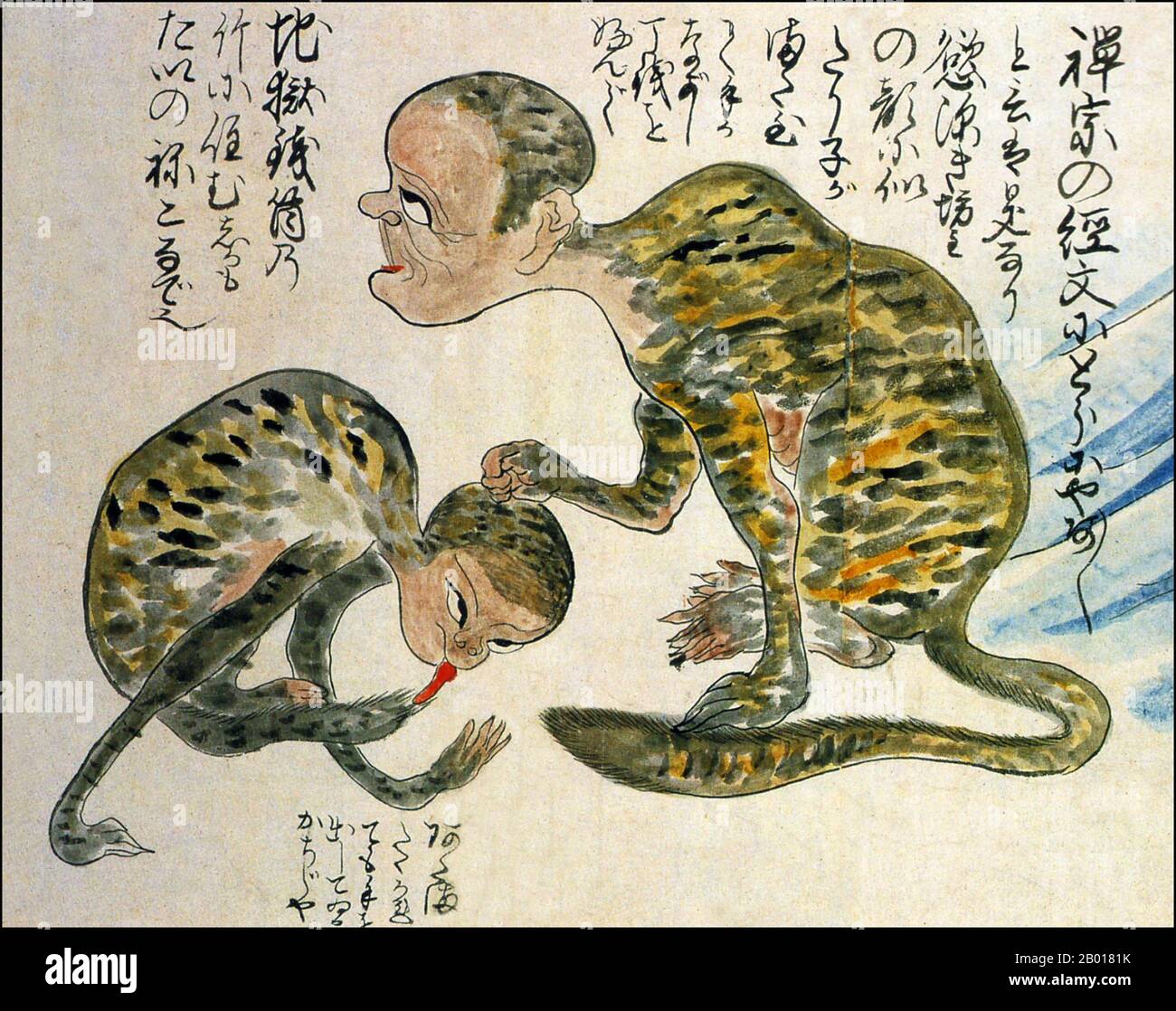 Japan: Two 'Tiger Meow Meow'. From the Kaikidan Ekotoba Monster Scroll, mid-19th century. 'Tiger Meow Meow' are people who have been transformed by greed into bizarre cat creatures. The Kaikidan Ekotoba is a mid-19th century handscroll that profiles 33 legendary monsters and human oddities, mostly from the Kyushu region of Japan, but with several from other countries, including China, Russia and Korea. The document, whose author is unknown, is in the possession of the Fukuoka City Museum. Stock Photohttps://www.alamy.com/image-license-details/?v=1https://www.alamy.com/japan-two-tiger-meow-meow-from-the-kaikidan-ekotoba-monster-scroll-mid-19th-century-tiger-meow-meow-are-people-who-have-been-transformed-by-greed-into-bizarre-cat-creatures-the-kaikidan-ekotoba-is-a-mid-19th-century-handscroll-that-profiles-33-legendary-monsters-and-human-oddities-mostly-from-the-kyushu-region-of-japan-but-with-several-from-other-countries-including-china-russia-and-korea-the-document-whose-author-is-unknown-is-in-the-possession-of-the-fukuoka-city-museum-image344235631.html
Japan: Two 'Tiger Meow Meow'. From the Kaikidan Ekotoba Monster Scroll, mid-19th century. 'Tiger Meow Meow' are people who have been transformed by greed into bizarre cat creatures. The Kaikidan Ekotoba is a mid-19th century handscroll that profiles 33 legendary monsters and human oddities, mostly from the Kyushu region of Japan, but with several from other countries, including China, Russia and Korea. The document, whose author is unknown, is in the possession of the Fukuoka City Museum. Stock Photohttps://www.alamy.com/image-license-details/?v=1https://www.alamy.com/japan-two-tiger-meow-meow-from-the-kaikidan-ekotoba-monster-scroll-mid-19th-century-tiger-meow-meow-are-people-who-have-been-transformed-by-greed-into-bizarre-cat-creatures-the-kaikidan-ekotoba-is-a-mid-19th-century-handscroll-that-profiles-33-legendary-monsters-and-human-oddities-mostly-from-the-kyushu-region-of-japan-but-with-several-from-other-countries-including-china-russia-and-korea-the-document-whose-author-is-unknown-is-in-the-possession-of-the-fukuoka-city-museum-image344235631.htmlRM2B0181K–Japan: Two 'Tiger Meow Meow'. From the Kaikidan Ekotoba Monster Scroll, mid-19th century. 'Tiger Meow Meow' are people who have been transformed by greed into bizarre cat creatures. The Kaikidan Ekotoba is a mid-19th century handscroll that profiles 33 legendary monsters and human oddities, mostly from the Kyushu region of Japan, but with several from other countries, including China, Russia and Korea. The document, whose author is unknown, is in the possession of the Fukuoka City Museum.
 Japan: A mikoshi-nyudo of Fukuoka. From the Kaikidan Ekotoba Monster Scroll, mid-19th century. The mikoshi-nyudo pictured here was encountered by a peasant on the road late one night in the Naka area of Fukuoka prefecture. The Kaikidan Ekotoba is a mid-19th century handscroll that profiles 33 legendary monsters and human oddities, mostly from the Kyushu region of Japan, but with several from other countries, including China, Russia and Korea. The document, whose author is unknown, is in the possession of the Fukuoka City Museum. Stock Photohttps://www.alamy.com/image-license-details/?v=1https://www.alamy.com/japan-a-mikoshi-nyudo-of-fukuoka-from-the-kaikidan-ekotoba-monster-scroll-mid-19th-century-the-mikoshi-nyudo-pictured-here-was-encountered-by-a-peasant-on-the-road-late-one-night-in-the-naka-area-of-fukuoka-prefecture-the-kaikidan-ekotoba-is-a-mid-19th-century-handscroll-that-profiles-33-legendary-monsters-and-human-oddities-mostly-from-the-kyushu-region-of-japan-but-with-several-from-other-countries-including-china-russia-and-korea-the-document-whose-author-is-unknown-is-in-the-possession-of-the-fukuoka-city-museum-image344235643.html
Japan: A mikoshi-nyudo of Fukuoka. From the Kaikidan Ekotoba Monster Scroll, mid-19th century. The mikoshi-nyudo pictured here was encountered by a peasant on the road late one night in the Naka area of Fukuoka prefecture. The Kaikidan Ekotoba is a mid-19th century handscroll that profiles 33 legendary monsters and human oddities, mostly from the Kyushu region of Japan, but with several from other countries, including China, Russia and Korea. The document, whose author is unknown, is in the possession of the Fukuoka City Museum. Stock Photohttps://www.alamy.com/image-license-details/?v=1https://www.alamy.com/japan-a-mikoshi-nyudo-of-fukuoka-from-the-kaikidan-ekotoba-monster-scroll-mid-19th-century-the-mikoshi-nyudo-pictured-here-was-encountered-by-a-peasant-on-the-road-late-one-night-in-the-naka-area-of-fukuoka-prefecture-the-kaikidan-ekotoba-is-a-mid-19th-century-handscroll-that-profiles-33-legendary-monsters-and-human-oddities-mostly-from-the-kyushu-region-of-japan-but-with-several-from-other-countries-including-china-russia-and-korea-the-document-whose-author-is-unknown-is-in-the-possession-of-the-fukuoka-city-museum-image344235643.htmlRM2B01823–Japan: A mikoshi-nyudo of Fukuoka. From the Kaikidan Ekotoba Monster Scroll, mid-19th century. The mikoshi-nyudo pictured here was encountered by a peasant on the road late one night in the Naka area of Fukuoka prefecture. The Kaikidan Ekotoba is a mid-19th century handscroll that profiles 33 legendary monsters and human oddities, mostly from the Kyushu region of Japan, but with several from other countries, including China, Russia and Korea. The document, whose author is unknown, is in the possession of the Fukuoka City Museum.
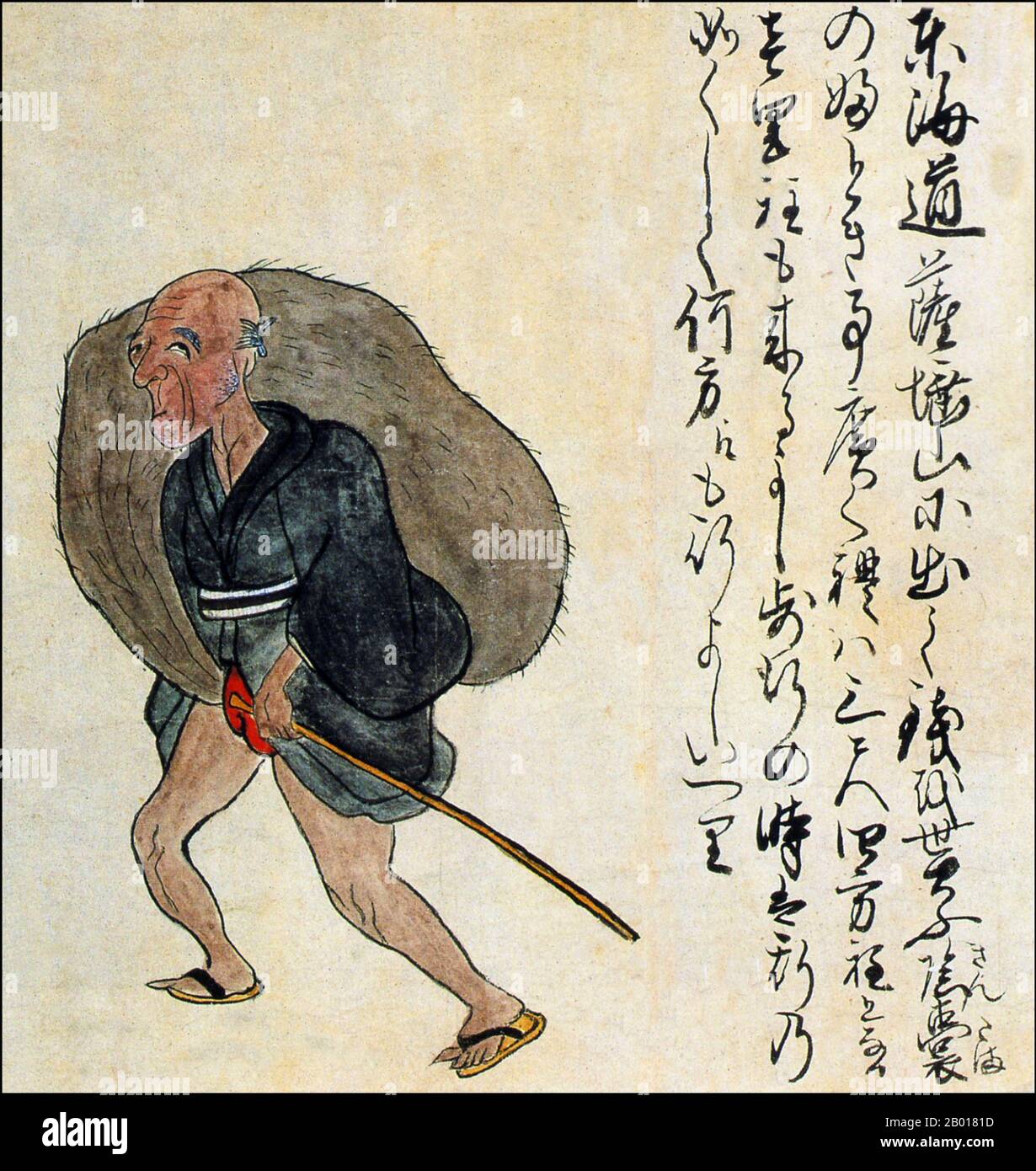 Japan: A man with swollen testicles. From the Kaikidan Ekotoba Monster Scroll, mid-19th century. Long ago, a man with massive testicles reportedly made a living as a sideshow attraction at Mount Satta, on the old Tokaido Road near the city of Shizuoka. His scrotum is said to have measured about a metre across. The Kaikidan Ekotoba is a mid-19th century handscroll that profiles 33 legendary monsters and human oddities, mostly from the Kyushu region of Japan, but with several from other countries, including China, Russia and Korea. Stock Photohttps://www.alamy.com/image-license-details/?v=1https://www.alamy.com/japan-a-man-with-swollen-testicles-from-the-kaikidan-ekotoba-monster-scroll-mid-19th-century-long-ago-a-man-with-massive-testicles-reportedly-made-a-living-as-a-sideshow-attraction-at-mount-satta-on-the-old-tokaido-road-near-the-city-of-shizuoka-his-scrotum-is-said-to-have-measured-about-a-metre-across-the-kaikidan-ekotoba-is-a-mid-19th-century-handscroll-that-profiles-33-legendary-monsters-and-human-oddities-mostly-from-the-kyushu-region-of-japan-but-with-several-from-other-countries-including-china-russia-and-korea-image344235625.html
Japan: A man with swollen testicles. From the Kaikidan Ekotoba Monster Scroll, mid-19th century. Long ago, a man with massive testicles reportedly made a living as a sideshow attraction at Mount Satta, on the old Tokaido Road near the city of Shizuoka. His scrotum is said to have measured about a metre across. The Kaikidan Ekotoba is a mid-19th century handscroll that profiles 33 legendary monsters and human oddities, mostly from the Kyushu region of Japan, but with several from other countries, including China, Russia and Korea. Stock Photohttps://www.alamy.com/image-license-details/?v=1https://www.alamy.com/japan-a-man-with-swollen-testicles-from-the-kaikidan-ekotoba-monster-scroll-mid-19th-century-long-ago-a-man-with-massive-testicles-reportedly-made-a-living-as-a-sideshow-attraction-at-mount-satta-on-the-old-tokaido-road-near-the-city-of-shizuoka-his-scrotum-is-said-to-have-measured-about-a-metre-across-the-kaikidan-ekotoba-is-a-mid-19th-century-handscroll-that-profiles-33-legendary-monsters-and-human-oddities-mostly-from-the-kyushu-region-of-japan-but-with-several-from-other-countries-including-china-russia-and-korea-image344235625.htmlRM2B0181D–Japan: A man with swollen testicles. From the Kaikidan Ekotoba Monster Scroll, mid-19th century. Long ago, a man with massive testicles reportedly made a living as a sideshow attraction at Mount Satta, on the old Tokaido Road near the city of Shizuoka. His scrotum is said to have measured about a metre across. The Kaikidan Ekotoba is a mid-19th century handscroll that profiles 33 legendary monsters and human oddities, mostly from the Kyushu region of Japan, but with several from other countries, including China, Russia and Korea.
 Japan: An 'ox woman' with no arms and deformed but dextrous feet, stringing coins. From the Kaikidan Ekotoba Monster Scroll, mid-19th century. The 'ox woman' pictured here was a sideshow attraction at Dazaifu Tenmangu shrine, Fukuoka prefecture, in the mid-18th century. The armless lady entertained audiences by using her peculiar feet to run string through the centre holes of coins. The Kaikidan Ekotoba is a mid-19th century handscroll that profiles 33 legendary monsters and human oddities, mostly from the Kyushu region of Japan, but with several from other countries. Stock Photohttps://www.alamy.com/image-license-details/?v=1https://www.alamy.com/japan-an-ox-woman-with-no-arms-and-deformed-but-dextrous-feet-stringing-coins-from-the-kaikidan-ekotoba-monster-scroll-mid-19th-century-the-ox-woman-pictured-here-was-a-sideshow-attraction-at-dazaifu-tenmangu-shrine-fukuoka-prefecture-in-the-mid-18th-century-the-armless-lady-entertained-audiences-by-using-her-peculiar-feet-to-run-string-through-the-centre-holes-of-coins-the-kaikidan-ekotoba-is-a-mid-19th-century-handscroll-that-profiles-33-legendary-monsters-and-human-oddities-mostly-from-the-kyushu-region-of-japan-but-with-several-from-other-countries-image344235629.html
Japan: An 'ox woman' with no arms and deformed but dextrous feet, stringing coins. From the Kaikidan Ekotoba Monster Scroll, mid-19th century. The 'ox woman' pictured here was a sideshow attraction at Dazaifu Tenmangu shrine, Fukuoka prefecture, in the mid-18th century. The armless lady entertained audiences by using her peculiar feet to run string through the centre holes of coins. The Kaikidan Ekotoba is a mid-19th century handscroll that profiles 33 legendary monsters and human oddities, mostly from the Kyushu region of Japan, but with several from other countries. Stock Photohttps://www.alamy.com/image-license-details/?v=1https://www.alamy.com/japan-an-ox-woman-with-no-arms-and-deformed-but-dextrous-feet-stringing-coins-from-the-kaikidan-ekotoba-monster-scroll-mid-19th-century-the-ox-woman-pictured-here-was-a-sideshow-attraction-at-dazaifu-tenmangu-shrine-fukuoka-prefecture-in-the-mid-18th-century-the-armless-lady-entertained-audiences-by-using-her-peculiar-feet-to-run-string-through-the-centre-holes-of-coins-the-kaikidan-ekotoba-is-a-mid-19th-century-handscroll-that-profiles-33-legendary-monsters-and-human-oddities-mostly-from-the-kyushu-region-of-japan-but-with-several-from-other-countries-image344235629.htmlRM2B0181H–Japan: An 'ox woman' with no arms and deformed but dextrous feet, stringing coins. From the Kaikidan Ekotoba Monster Scroll, mid-19th century. The 'ox woman' pictured here was a sideshow attraction at Dazaifu Tenmangu shrine, Fukuoka prefecture, in the mid-18th century. The armless lady entertained audiences by using her peculiar feet to run string through the centre holes of coins. The Kaikidan Ekotoba is a mid-19th century handscroll that profiles 33 legendary monsters and human oddities, mostly from the Kyushu region of Japan, but with several from other countries.
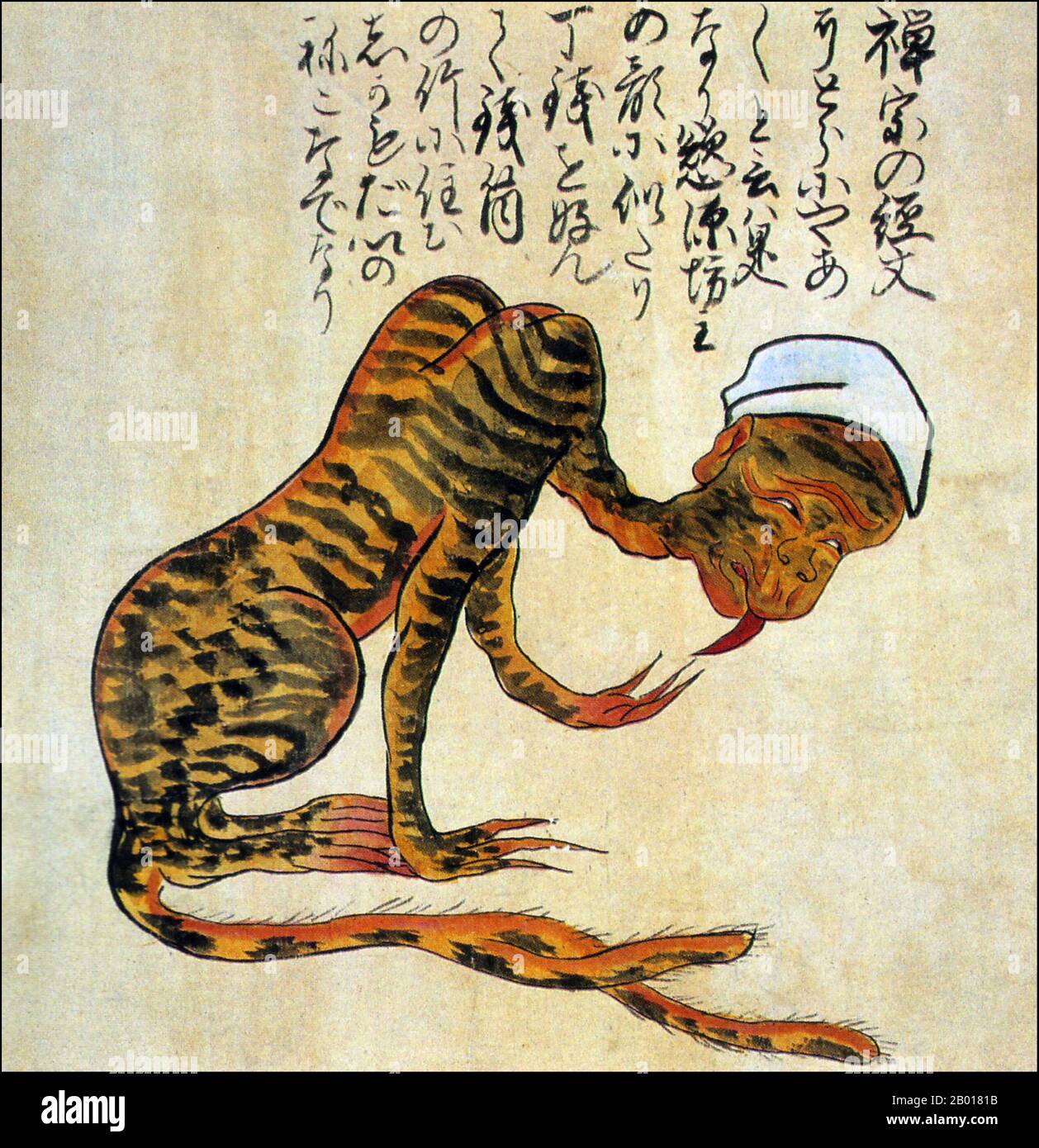 Japan: 'Tiger Meow Meow', a Zenshu priest transformed into a monstrous feline creature. From the Kaikidan Ekotoba Monster Scroll, mid-19th century. The illustration depicts a Zenshu priest who was transformed by greed into a strange feline creature with three toes on each paw and the forked tail of a nekomata. The Kaikidan Ekotoba is a mid-19th century handscroll that profiles 33 legendary monsters and human oddities, mostly from the Kyushu region of Japan, but with several from other countries, including China, Russia and Korea. Stock Photohttps://www.alamy.com/image-license-details/?v=1https://www.alamy.com/japan-tiger-meow-meow-a-zenshu-priest-transformed-into-a-monstrous-feline-creature-from-the-kaikidan-ekotoba-monster-scroll-mid-19th-century-the-illustration-depicts-a-zenshu-priest-who-was-transformed-by-greed-into-a-strange-feline-creature-with-three-toes-on-each-paw-and-the-forked-tail-of-a-nekomata-the-kaikidan-ekotoba-is-a-mid-19th-century-handscroll-that-profiles-33-legendary-monsters-and-human-oddities-mostly-from-the-kyushu-region-of-japan-but-with-several-from-other-countries-including-china-russia-and-korea-image344235623.html
Japan: 'Tiger Meow Meow', a Zenshu priest transformed into a monstrous feline creature. From the Kaikidan Ekotoba Monster Scroll, mid-19th century. The illustration depicts a Zenshu priest who was transformed by greed into a strange feline creature with three toes on each paw and the forked tail of a nekomata. The Kaikidan Ekotoba is a mid-19th century handscroll that profiles 33 legendary monsters and human oddities, mostly from the Kyushu region of Japan, but with several from other countries, including China, Russia and Korea. Stock Photohttps://www.alamy.com/image-license-details/?v=1https://www.alamy.com/japan-tiger-meow-meow-a-zenshu-priest-transformed-into-a-monstrous-feline-creature-from-the-kaikidan-ekotoba-monster-scroll-mid-19th-century-the-illustration-depicts-a-zenshu-priest-who-was-transformed-by-greed-into-a-strange-feline-creature-with-three-toes-on-each-paw-and-the-forked-tail-of-a-nekomata-the-kaikidan-ekotoba-is-a-mid-19th-century-handscroll-that-profiles-33-legendary-monsters-and-human-oddities-mostly-from-the-kyushu-region-of-japan-but-with-several-from-other-countries-including-china-russia-and-korea-image344235623.htmlRM2B0181B–Japan: 'Tiger Meow Meow', a Zenshu priest transformed into a monstrous feline creature. From the Kaikidan Ekotoba Monster Scroll, mid-19th century. The illustration depicts a Zenshu priest who was transformed by greed into a strange feline creature with three toes on each paw and the forked tail of a nekomata. The Kaikidan Ekotoba is a mid-19th century handscroll that profiles 33 legendary monsters and human oddities, mostly from the Kyushu region of Japan, but with several from other countries, including China, Russia and Korea.
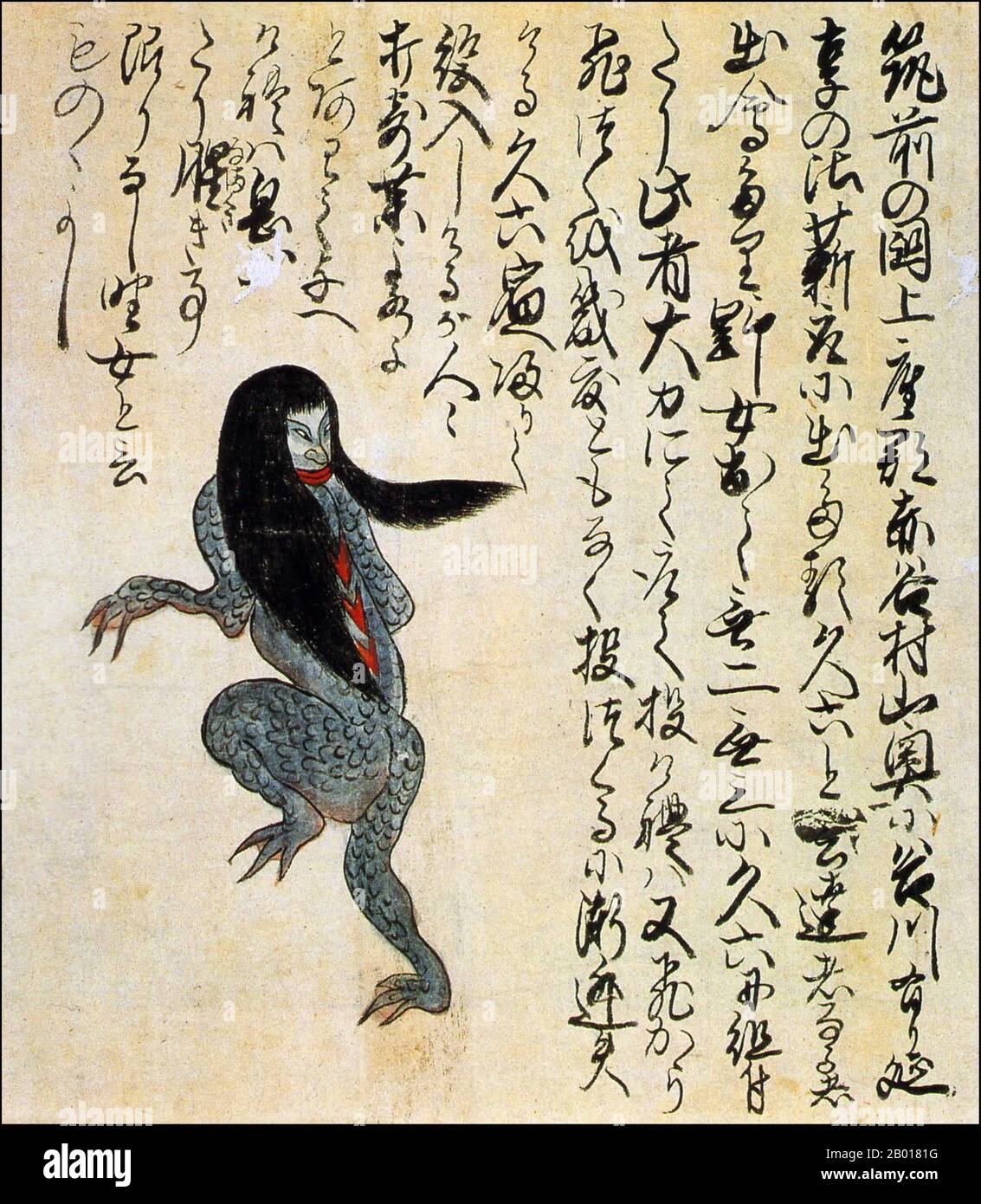 Japan: A 'wild woman' with scaly skin and webbed hands and feet. From the Kaikidan Ekotoba Monster Scroll, mid-19th century. The 'wild woman' shown here appears to be an aquatic humanoid with scaly skin, webbed hands and feet (each with three fingers and toes), long black hair, and a large red mouth. People claim to have encountered the creature in the 1750s in mountain streams in the Asakura area of Fukuoka prefecture. The Kaikidan Ekotoba is a mid-19th century handscroll that profiles 33 legendary monsters and human oddities, mostly from the Kyushu region of Japan. Stock Photohttps://www.alamy.com/image-license-details/?v=1https://www.alamy.com/japan-a-wild-woman-with-scaly-skin-and-webbed-hands-and-feet-from-the-kaikidan-ekotoba-monster-scroll-mid-19th-century-the-wild-woman-shown-here-appears-to-be-an-aquatic-humanoid-with-scaly-skin-webbed-hands-and-feet-each-with-three-fingers-and-toes-long-black-hair-and-a-large-red-mouth-people-claim-to-have-encountered-the-creature-in-the-1750s-in-mountain-streams-in-the-asakura-area-of-fukuoka-prefecture-the-kaikidan-ekotoba-is-a-mid-19th-century-handscroll-that-profiles-33-legendary-monsters-and-human-oddities-mostly-from-the-kyushu-region-of-japan-image344235628.html
Japan: A 'wild woman' with scaly skin and webbed hands and feet. From the Kaikidan Ekotoba Monster Scroll, mid-19th century. The 'wild woman' shown here appears to be an aquatic humanoid with scaly skin, webbed hands and feet (each with three fingers and toes), long black hair, and a large red mouth. People claim to have encountered the creature in the 1750s in mountain streams in the Asakura area of Fukuoka prefecture. The Kaikidan Ekotoba is a mid-19th century handscroll that profiles 33 legendary monsters and human oddities, mostly from the Kyushu region of Japan. Stock Photohttps://www.alamy.com/image-license-details/?v=1https://www.alamy.com/japan-a-wild-woman-with-scaly-skin-and-webbed-hands-and-feet-from-the-kaikidan-ekotoba-monster-scroll-mid-19th-century-the-wild-woman-shown-here-appears-to-be-an-aquatic-humanoid-with-scaly-skin-webbed-hands-and-feet-each-with-three-fingers-and-toes-long-black-hair-and-a-large-red-mouth-people-claim-to-have-encountered-the-creature-in-the-1750s-in-mountain-streams-in-the-asakura-area-of-fukuoka-prefecture-the-kaikidan-ekotoba-is-a-mid-19th-century-handscroll-that-profiles-33-legendary-monsters-and-human-oddities-mostly-from-the-kyushu-region-of-japan-image344235628.htmlRM2B0181G–Japan: A 'wild woman' with scaly skin and webbed hands and feet. From the Kaikidan Ekotoba Monster Scroll, mid-19th century. The 'wild woman' shown here appears to be an aquatic humanoid with scaly skin, webbed hands and feet (each with three fingers and toes), long black hair, and a large red mouth. People claim to have encountered the creature in the 1750s in mountain streams in the Asakura area of Fukuoka prefecture. The Kaikidan Ekotoba is a mid-19th century handscroll that profiles 33 legendary monsters and human oddities, mostly from the Kyushu region of Japan.
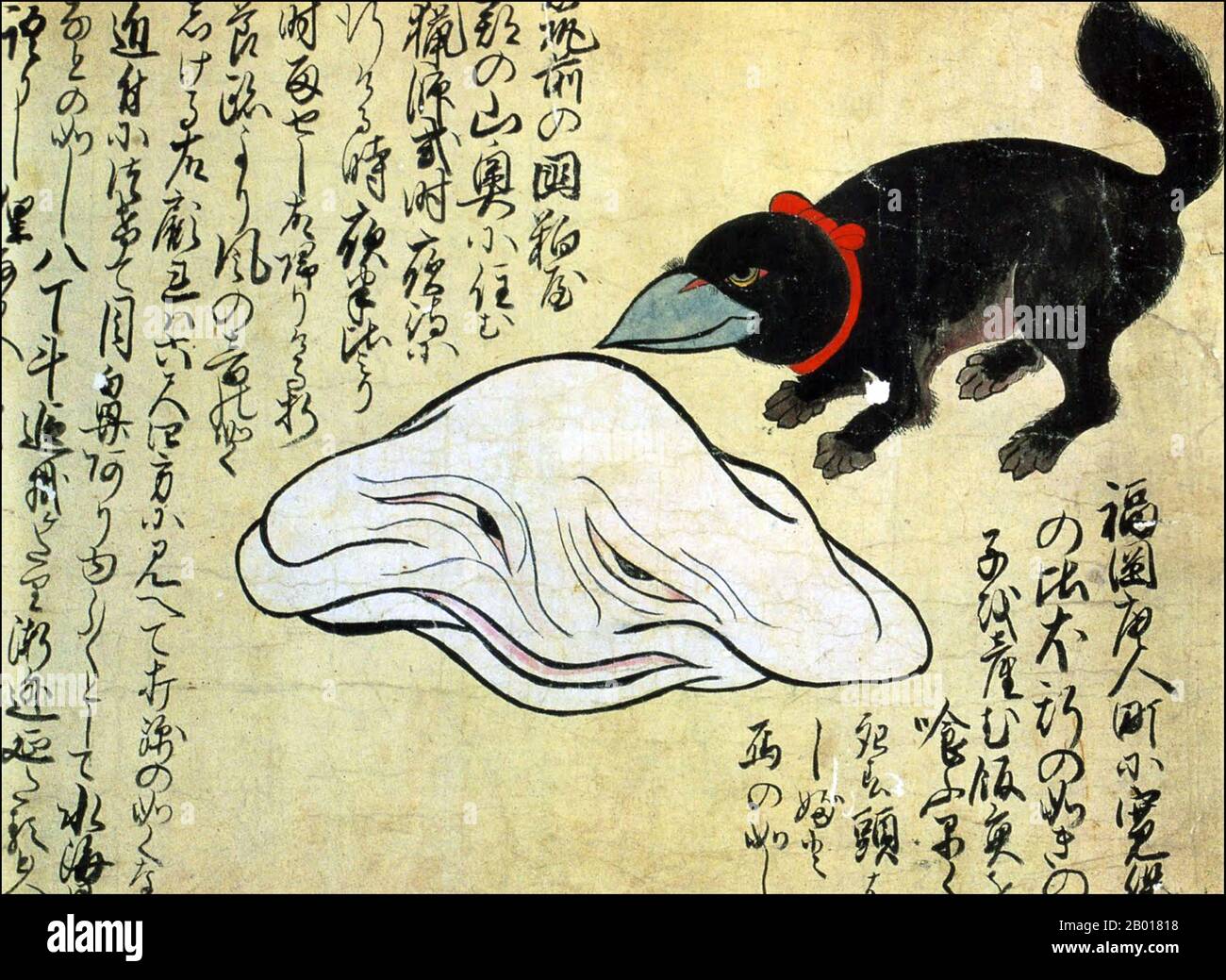 Japan: A white monster and a bird-dog hybrid monster. From the Kaikidan Ekotoba Monster Scroll, mid-19th century. The black creature on the right was born by a dog that mated with a bird in the city of Fukuoka in the early 1740s. Next to the bird-dog hybrid is an amorphous white monster, also encountered in Fukuoka, which is said to have measured about 180 centimetres (6 ft) across. People at the time believed this creature was a Tanuki (Japanese raccoon dog) that had shape-shifted. The Kaikidan Ekotoba is a mid-19th century handscroll that profiles 33 legendary monsters and human oddities. Stock Photohttps://www.alamy.com/image-license-details/?v=1https://www.alamy.com/japan-a-white-monster-and-a-bird-dog-hybrid-monster-from-the-kaikidan-ekotoba-monster-scroll-mid-19th-century-the-black-creature-on-the-right-was-born-by-a-dog-that-mated-with-a-bird-in-the-city-of-fukuoka-in-the-early-1740s-next-to-the-bird-dog-hybrid-is-an-amorphous-white-monster-also-encountered-in-fukuoka-which-is-said-to-have-measured-about-180-centimetres-6-ft-across-people-at-the-time-believed-this-creature-was-a-tanuki-japanese-raccoon-dog-that-had-shape-shifted-the-kaikidan-ekotoba-is-a-mid-19th-century-handscroll-that-profiles-33-legendary-monsters-and-human-oddities-image344235620.html
Japan: A white monster and a bird-dog hybrid monster. From the Kaikidan Ekotoba Monster Scroll, mid-19th century. The black creature on the right was born by a dog that mated with a bird in the city of Fukuoka in the early 1740s. Next to the bird-dog hybrid is an amorphous white monster, also encountered in Fukuoka, which is said to have measured about 180 centimetres (6 ft) across. People at the time believed this creature was a Tanuki (Japanese raccoon dog) that had shape-shifted. The Kaikidan Ekotoba is a mid-19th century handscroll that profiles 33 legendary monsters and human oddities. Stock Photohttps://www.alamy.com/image-license-details/?v=1https://www.alamy.com/japan-a-white-monster-and-a-bird-dog-hybrid-monster-from-the-kaikidan-ekotoba-monster-scroll-mid-19th-century-the-black-creature-on-the-right-was-born-by-a-dog-that-mated-with-a-bird-in-the-city-of-fukuoka-in-the-early-1740s-next-to-the-bird-dog-hybrid-is-an-amorphous-white-monster-also-encountered-in-fukuoka-which-is-said-to-have-measured-about-180-centimetres-6-ft-across-people-at-the-time-believed-this-creature-was-a-tanuki-japanese-raccoon-dog-that-had-shape-shifted-the-kaikidan-ekotoba-is-a-mid-19th-century-handscroll-that-profiles-33-legendary-monsters-and-human-oddities-image344235620.htmlRM2B01818–Japan: A white monster and a bird-dog hybrid monster. From the Kaikidan Ekotoba Monster Scroll, mid-19th century. The black creature on the right was born by a dog that mated with a bird in the city of Fukuoka in the early 1740s. Next to the bird-dog hybrid is an amorphous white monster, also encountered in Fukuoka, which is said to have measured about 180 centimetres (6 ft) across. People at the time believed this creature was a Tanuki (Japanese raccoon dog) that had shape-shifted. The Kaikidan Ekotoba is a mid-19th century handscroll that profiles 33 legendary monsters and human oddities.
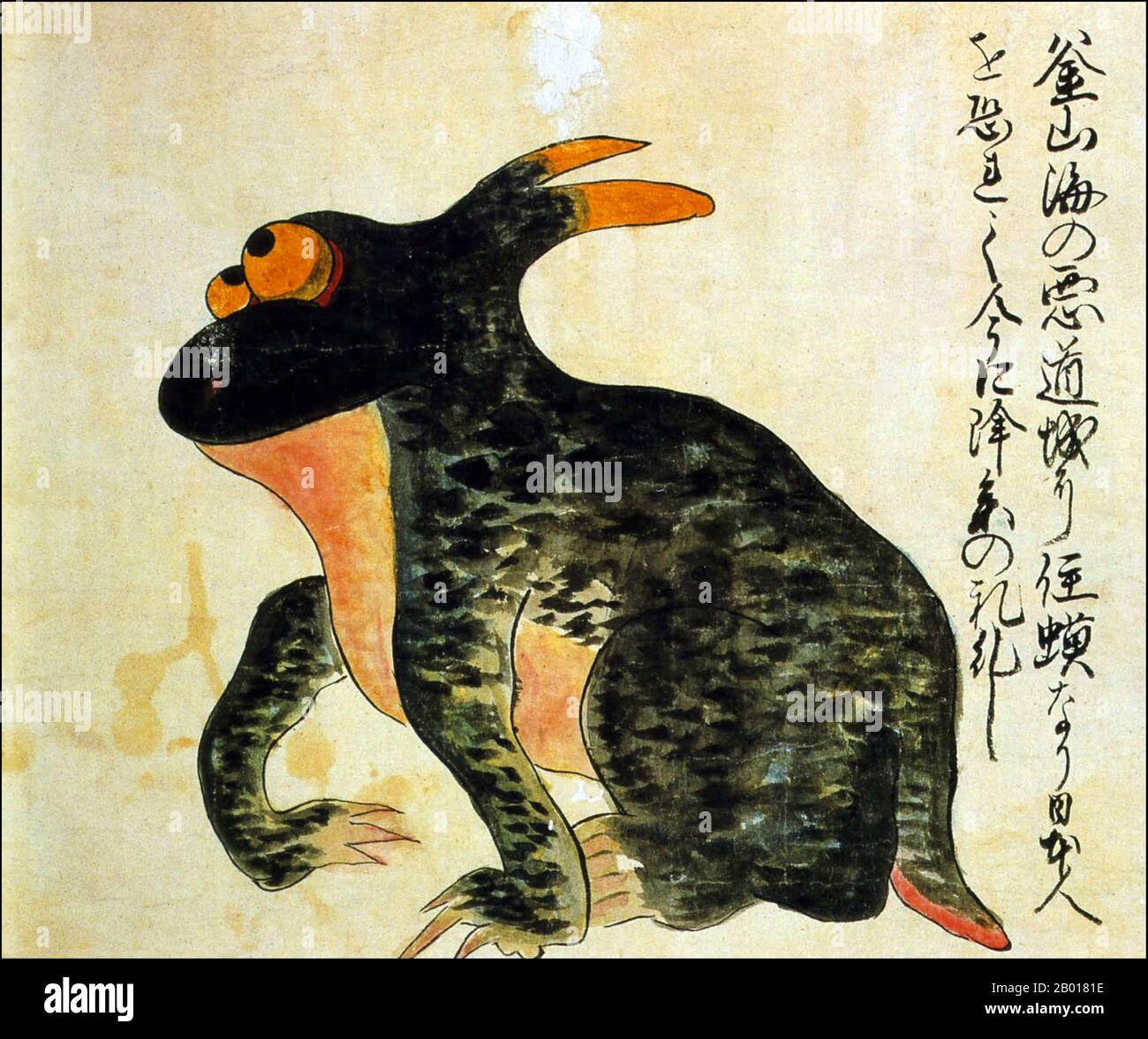 Japan: A huge horned toad believed to inhabit the sea off Pusan (Busan), Korea. From the Kaikidan Ekotoba Monster Scroll, mid-19th century. The Kaikidan Ekotoba is a mid-19th century handscroll that profiles 33 legendary monsters and human oddities, mostly from the Kyushu region of Japan, but with several from other countries, including China, Russia and Korea. The document, whose author is unknown, is in the possession of the Fukuoka City Museum. Stock Photohttps://www.alamy.com/image-license-details/?v=1https://www.alamy.com/japan-a-huge-horned-toad-believed-to-inhabit-the-sea-off-pusan-busan-korea-from-the-kaikidan-ekotoba-monster-scroll-mid-19th-century-the-kaikidan-ekotoba-is-a-mid-19th-century-handscroll-that-profiles-33-legendary-monsters-and-human-oddities-mostly-from-the-kyushu-region-of-japan-but-with-several-from-other-countries-including-china-russia-and-korea-the-document-whose-author-is-unknown-is-in-the-possession-of-the-fukuoka-city-museum-image344235626.html
Japan: A huge horned toad believed to inhabit the sea off Pusan (Busan), Korea. From the Kaikidan Ekotoba Monster Scroll, mid-19th century. The Kaikidan Ekotoba is a mid-19th century handscroll that profiles 33 legendary monsters and human oddities, mostly from the Kyushu region of Japan, but with several from other countries, including China, Russia and Korea. The document, whose author is unknown, is in the possession of the Fukuoka City Museum. Stock Photohttps://www.alamy.com/image-license-details/?v=1https://www.alamy.com/japan-a-huge-horned-toad-believed-to-inhabit-the-sea-off-pusan-busan-korea-from-the-kaikidan-ekotoba-monster-scroll-mid-19th-century-the-kaikidan-ekotoba-is-a-mid-19th-century-handscroll-that-profiles-33-legendary-monsters-and-human-oddities-mostly-from-the-kyushu-region-of-japan-but-with-several-from-other-countries-including-china-russia-and-korea-the-document-whose-author-is-unknown-is-in-the-possession-of-the-fukuoka-city-museum-image344235626.htmlRM2B0181E–Japan: A huge horned toad believed to inhabit the sea off Pusan (Busan), Korea. From the Kaikidan Ekotoba Monster Scroll, mid-19th century. The Kaikidan Ekotoba is a mid-19th century handscroll that profiles 33 legendary monsters and human oddities, mostly from the Kyushu region of Japan, but with several from other countries, including China, Russia and Korea. The document, whose author is unknown, is in the possession of the Fukuoka City Museum.
RM2B0181P–Japan: A 'Korean monk' reborn as a 'kappa' water sprite, playing a 'gekkin' moon guitar. From the Kaikidan Ekotoba Monster Scroll, mid-19th century. The Kaikidan Ekotoba is a mid-19th century handscroll that profiles 33 legendary monsters and human oddities, mostly from the Kyushu region of Japan, but with several from other countries, including China, Russia and Korea. The document, whose author is unknown, is in the possession of the Fukuoka City Museum.
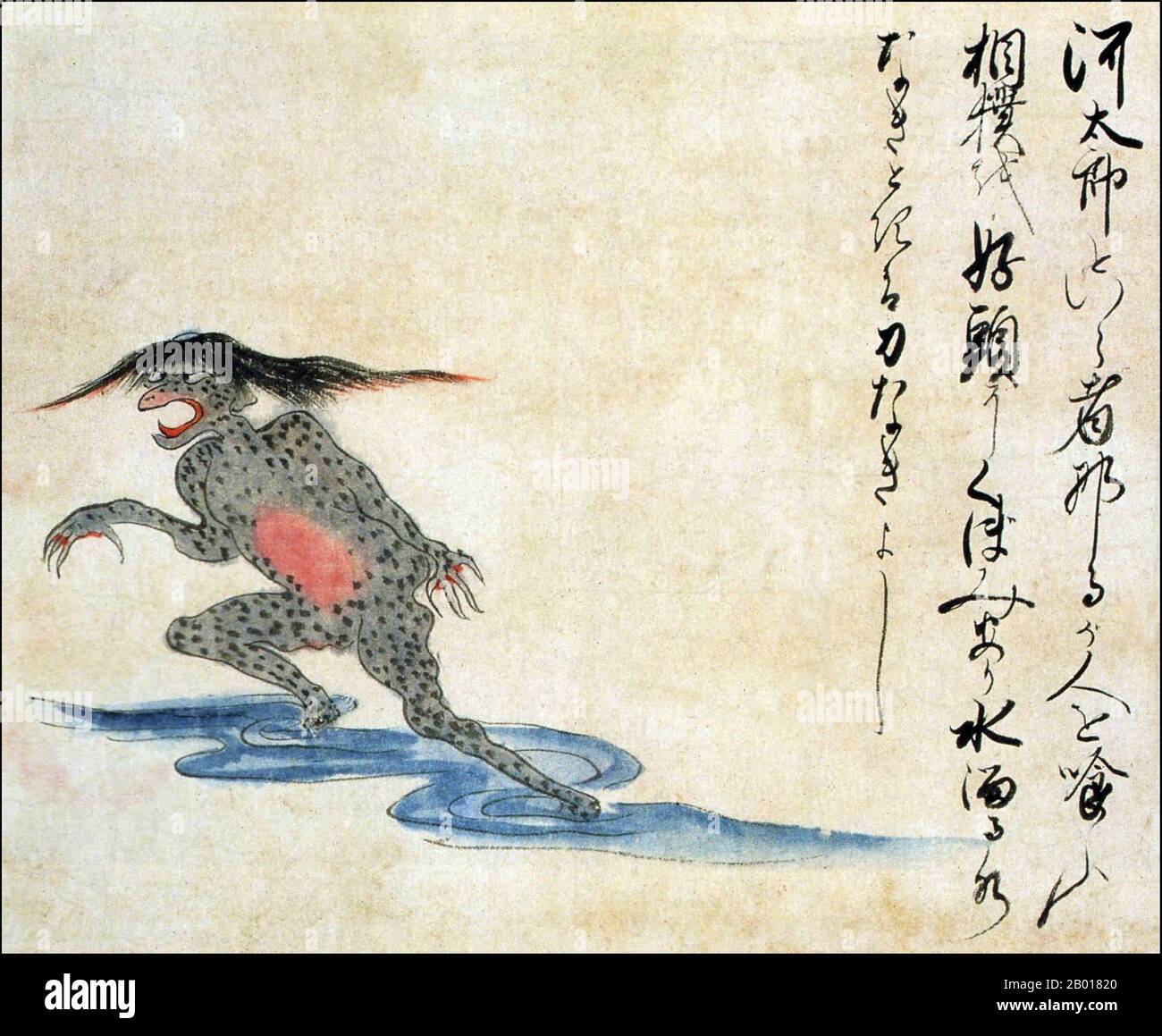 Japan: A 'kawataro' water imp. From the Kaikidan Ekotoba Monster Scroll, mid-19th century. The kawataro is a variety of kappa or water imp which likes to eat people and to practice sumo. An indentation on top of the creature's head is filled with water. The kawataro becomes weak when the water spills out. The Kaikidan Ekotoba is a mid-19th century handscroll that profiles 33 legendary monsters and human oddities, mostly from the Kyushu region of Japan, but with several from other countries, including China, Russia and Korea. Stock Photohttps://www.alamy.com/image-license-details/?v=1https://www.alamy.com/japan-a-kawataro-water-imp-from-the-kaikidan-ekotoba-monster-scroll-mid-19th-century-the-kawataro-is-a-variety-of-kappa-or-water-imp-which-likes-to-eat-people-and-to-practice-sumo-an-indentation-on-top-of-the-creatures-head-is-filled-with-water-the-kawataro-becomes-weak-when-the-water-spills-out-the-kaikidan-ekotoba-is-a-mid-19th-century-handscroll-that-profiles-33-legendary-monsters-and-human-oddities-mostly-from-the-kyushu-region-of-japan-but-with-several-from-other-countries-including-china-russia-and-korea-image344235640.html
Japan: A 'kawataro' water imp. From the Kaikidan Ekotoba Monster Scroll, mid-19th century. The kawataro is a variety of kappa or water imp which likes to eat people and to practice sumo. An indentation on top of the creature's head is filled with water. The kawataro becomes weak when the water spills out. The Kaikidan Ekotoba is a mid-19th century handscroll that profiles 33 legendary monsters and human oddities, mostly from the Kyushu region of Japan, but with several from other countries, including China, Russia and Korea. Stock Photohttps://www.alamy.com/image-license-details/?v=1https://www.alamy.com/japan-a-kawataro-water-imp-from-the-kaikidan-ekotoba-monster-scroll-mid-19th-century-the-kawataro-is-a-variety-of-kappa-or-water-imp-which-likes-to-eat-people-and-to-practice-sumo-an-indentation-on-top-of-the-creatures-head-is-filled-with-water-the-kawataro-becomes-weak-when-the-water-spills-out-the-kaikidan-ekotoba-is-a-mid-19th-century-handscroll-that-profiles-33-legendary-monsters-and-human-oddities-mostly-from-the-kyushu-region-of-japan-but-with-several-from-other-countries-including-china-russia-and-korea-image344235640.htmlRM2B01820–Japan: A 'kawataro' water imp. From the Kaikidan Ekotoba Monster Scroll, mid-19th century. The kawataro is a variety of kappa or water imp which likes to eat people and to practice sumo. An indentation on top of the creature's head is filled with water. The kawataro becomes weak when the water spills out. The Kaikidan Ekotoba is a mid-19th century handscroll that profiles 33 legendary monsters and human oddities, mostly from the Kyushu region of Japan, but with several from other countries, including China, Russia and Korea.
 Japan: A 'lantern man' with a collapsible head. From the Kaikidan Ekotoba Monster Scroll, mid-19th century. In the early decades of the 18th century, a man with a malleable head made a living as a popular sideshow attraction. It is said that he could collapse his head like a traditional paper lantern. The Kaikidan Ekotoba is a mid-19th century handscroll that profiles 33 legendary monsters and human oddities, mostly from the Kyushu region of Japan, but with several from other countries, including China, Russia and Korea. Stock Photohttps://www.alamy.com/image-license-details/?v=1https://www.alamy.com/japan-a-lantern-man-with-a-collapsible-head-from-the-kaikidan-ekotoba-monster-scroll-mid-19th-century-in-the-early-decades-of-the-18th-century-a-man-with-a-malleable-head-made-a-living-as-a-popular-sideshow-attraction-it-is-said-that-he-could-collapse-his-head-like-a-traditional-paper-lantern-the-kaikidan-ekotoba-is-a-mid-19th-century-handscroll-that-profiles-33-legendary-monsters-and-human-oddities-mostly-from-the-kyushu-region-of-japan-but-with-several-from-other-countries-including-china-russia-and-korea-image344235632.html
Japan: A 'lantern man' with a collapsible head. From the Kaikidan Ekotoba Monster Scroll, mid-19th century. In the early decades of the 18th century, a man with a malleable head made a living as a popular sideshow attraction. It is said that he could collapse his head like a traditional paper lantern. The Kaikidan Ekotoba is a mid-19th century handscroll that profiles 33 legendary monsters and human oddities, mostly from the Kyushu region of Japan, but with several from other countries, including China, Russia and Korea. Stock Photohttps://www.alamy.com/image-license-details/?v=1https://www.alamy.com/japan-a-lantern-man-with-a-collapsible-head-from-the-kaikidan-ekotoba-monster-scroll-mid-19th-century-in-the-early-decades-of-the-18th-century-a-man-with-a-malleable-head-made-a-living-as-a-popular-sideshow-attraction-it-is-said-that-he-could-collapse-his-head-like-a-traditional-paper-lantern-the-kaikidan-ekotoba-is-a-mid-19th-century-handscroll-that-profiles-33-legendary-monsters-and-human-oddities-mostly-from-the-kyushu-region-of-japan-but-with-several-from-other-countries-including-china-russia-and-korea-image344235632.htmlRM2B0181M–Japan: A 'lantern man' with a collapsible head. From the Kaikidan Ekotoba Monster Scroll, mid-19th century. In the early decades of the 18th century, a man with a malleable head made a living as a popular sideshow attraction. It is said that he could collapse his head like a traditional paper lantern. The Kaikidan Ekotoba is a mid-19th century handscroll that profiles 33 legendary monsters and human oddities, mostly from the Kyushu region of Japan, but with several from other countries, including China, Russia and Korea.
 Japan: The Hitodama Oroshiya or 'Russian Fireball'. From the Kaikidan Ekotoba Monster Scroll, mid-19th century. During heavy winds the Russian hitodama, a fiery apparition composed of spirits of the recently departed, can be heard to say, 'Oroshiya, oroshiya' ('Let me down'). There is speculation that the author dreamed up the creature based on a play on words as 'oroshiya' sounds like the old Japanese pronunciation of 'Russia'. The Kaikidan Ekotoba is a mid-19th century handscroll that profiles 33 legendary monsters and human oddities, mostly from the Kyushu region of Japan. Stock Photohttps://www.alamy.com/image-license-details/?v=1https://www.alamy.com/japan-the-hitodama-oroshiya-or-russian-fireball-from-the-kaikidan-ekotoba-monster-scroll-mid-19th-century-during-heavy-winds-the-russian-hitodama-a-fiery-apparition-composed-of-spirits-of-the-recently-departed-can-be-heard-to-say-oroshiya-oroshiya-let-me-down-there-is-speculation-that-the-author-dreamed-up-the-creature-based-on-a-play-on-words-as-oroshiya-sounds-like-the-old-japanese-pronunciation-of-russia-the-kaikidan-ekotoba-is-a-mid-19th-century-handscroll-that-profiles-33-legendary-monsters-and-human-oddities-mostly-from-the-kyushu-region-of-japan-image344235622.html
Japan: The Hitodama Oroshiya or 'Russian Fireball'. From the Kaikidan Ekotoba Monster Scroll, mid-19th century. During heavy winds the Russian hitodama, a fiery apparition composed of spirits of the recently departed, can be heard to say, 'Oroshiya, oroshiya' ('Let me down'). There is speculation that the author dreamed up the creature based on a play on words as 'oroshiya' sounds like the old Japanese pronunciation of 'Russia'. The Kaikidan Ekotoba is a mid-19th century handscroll that profiles 33 legendary monsters and human oddities, mostly from the Kyushu region of Japan. Stock Photohttps://www.alamy.com/image-license-details/?v=1https://www.alamy.com/japan-the-hitodama-oroshiya-or-russian-fireball-from-the-kaikidan-ekotoba-monster-scroll-mid-19th-century-during-heavy-winds-the-russian-hitodama-a-fiery-apparition-composed-of-spirits-of-the-recently-departed-can-be-heard-to-say-oroshiya-oroshiya-let-me-down-there-is-speculation-that-the-author-dreamed-up-the-creature-based-on-a-play-on-words-as-oroshiya-sounds-like-the-old-japanese-pronunciation-of-russia-the-kaikidan-ekotoba-is-a-mid-19th-century-handscroll-that-profiles-33-legendary-monsters-and-human-oddities-mostly-from-the-kyushu-region-of-japan-image344235622.htmlRM2B0181A–Japan: The Hitodama Oroshiya or 'Russian Fireball'. From the Kaikidan Ekotoba Monster Scroll, mid-19th century. During heavy winds the Russian hitodama, a fiery apparition composed of spirits of the recently departed, can be heard to say, 'Oroshiya, oroshiya' ('Let me down'). There is speculation that the author dreamed up the creature based on a play on words as 'oroshiya' sounds like the old Japanese pronunciation of 'Russia'. The Kaikidan Ekotoba is a mid-19th century handscroll that profiles 33 legendary monsters and human oddities, mostly from the Kyushu region of Japan.
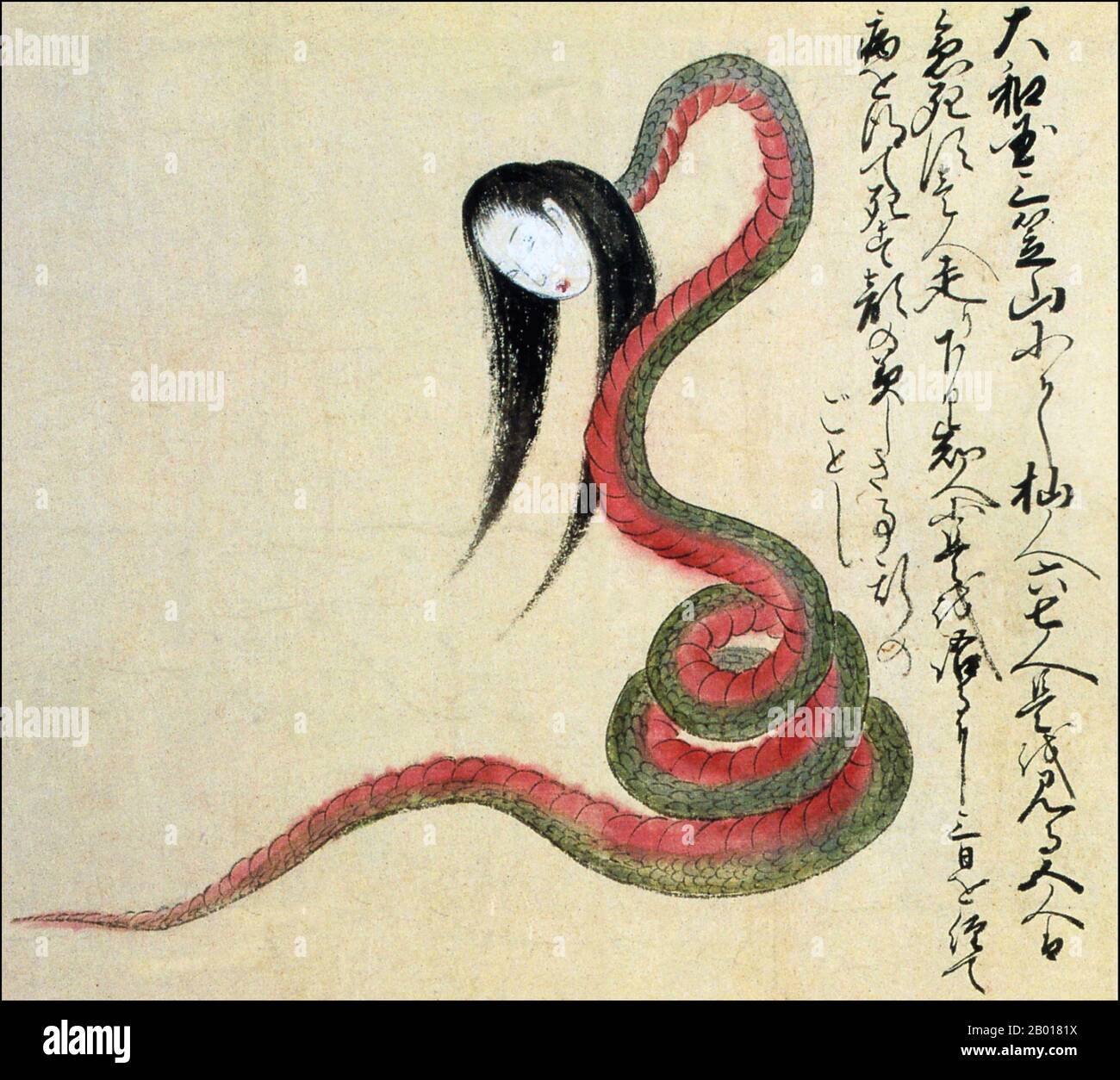 Japan: The 'snake woman' of Nara. From the Kaikidan Ekotoba Monster Scroll, mid-19th century. The snake woman pictured here was reportedly encountered by six people on Mt. Mikasa in Nara prefecture. Five of the eyewitnesses died instantly. The sixth person survived long enough to make it home and tell the tale, but he grew ill and died three days later. The snake-bodied woman resembles the notorious nure-onna, except that this one has a beautiful face. The Kaikidan Ekotoba is a mid-19th century handscroll that profiles 33 legendary monsters and human oddities, mostly from the Kyushu region. Stock Photohttps://www.alamy.com/image-license-details/?v=1https://www.alamy.com/japan-the-snake-woman-of-nara-from-the-kaikidan-ekotoba-monster-scroll-mid-19th-century-the-snake-woman-pictured-here-was-reportedly-encountered-by-six-people-on-mt-mikasa-in-nara-prefecture-five-of-the-eyewitnesses-died-instantly-the-sixth-person-survived-long-enough-to-make-it-home-and-tell-the-tale-but-he-grew-ill-and-died-three-days-later-the-snake-bodied-woman-resembles-the-notorious-nure-onna-except-that-this-one-has-a-beautiful-face-the-kaikidan-ekotoba-is-a-mid-19th-century-handscroll-that-profiles-33-legendary-monsters-and-human-oddities-mostly-from-the-kyushu-region-image344235638.html
Japan: The 'snake woman' of Nara. From the Kaikidan Ekotoba Monster Scroll, mid-19th century. The snake woman pictured here was reportedly encountered by six people on Mt. Mikasa in Nara prefecture. Five of the eyewitnesses died instantly. The sixth person survived long enough to make it home and tell the tale, but he grew ill and died three days later. The snake-bodied woman resembles the notorious nure-onna, except that this one has a beautiful face. The Kaikidan Ekotoba is a mid-19th century handscroll that profiles 33 legendary monsters and human oddities, mostly from the Kyushu region. Stock Photohttps://www.alamy.com/image-license-details/?v=1https://www.alamy.com/japan-the-snake-woman-of-nara-from-the-kaikidan-ekotoba-monster-scroll-mid-19th-century-the-snake-woman-pictured-here-was-reportedly-encountered-by-six-people-on-mt-mikasa-in-nara-prefecture-five-of-the-eyewitnesses-died-instantly-the-sixth-person-survived-long-enough-to-make-it-home-and-tell-the-tale-but-he-grew-ill-and-died-three-days-later-the-snake-bodied-woman-resembles-the-notorious-nure-onna-except-that-this-one-has-a-beautiful-face-the-kaikidan-ekotoba-is-a-mid-19th-century-handscroll-that-profiles-33-legendary-monsters-and-human-oddities-mostly-from-the-kyushu-region-image344235638.htmlRM2B0181X–Japan: The 'snake woman' of Nara. From the Kaikidan Ekotoba Monster Scroll, mid-19th century. The snake woman pictured here was reportedly encountered by six people on Mt. Mikasa in Nara prefecture. Five of the eyewitnesses died instantly. The sixth person survived long enough to make it home and tell the tale, but he grew ill and died three days later. The snake-bodied woman resembles the notorious nure-onna, except that this one has a beautiful face. The Kaikidan Ekotoba is a mid-19th century handscroll that profiles 33 legendary monsters and human oddities, mostly from the Kyushu region.
 The nekomata is a cat monster with a forked tail and a taste for human flesh. The creature's powers include the ability to talk, walk on hind legs, shape-shift, fly, and even resurrect the dead. The nekomata pictured here was encountered in the Nasuno area of Tochigi prefecture. The Kaikidan Ekotoba is a mid-19th century handscroll that profiles 33 legendary monsters and human oddities, mostly from the Kyushu region of Japan, but with several from other countries, including China, Russia and Korea. The document, whose author is unknown, is in the possession of the Fukuoka City Museum. Stock Photohttps://www.alamy.com/image-license-details/?v=1https://www.alamy.com/the-nekomata-is-a-cat-monster-with-a-forked-tail-and-a-taste-for-human-flesh-the-creatures-powers-include-the-ability-to-talk-walk-on-hind-legs-shape-shift-fly-and-even-resurrect-the-dead-the-nekomata-pictured-here-was-encountered-in-the-nasuno-area-of-tochigi-prefecture-the-kaikidan-ekotoba-is-a-mid-19th-century-handscroll-that-profiles-33-legendary-monsters-and-human-oddities-mostly-from-the-kyushu-region-of-japan-but-with-several-from-other-countries-including-china-russia-and-korea-the-document-whose-author-is-unknown-is-in-the-possession-of-the-fukuoka-city-museum-image344235635.html
The nekomata is a cat monster with a forked tail and a taste for human flesh. The creature's powers include the ability to talk, walk on hind legs, shape-shift, fly, and even resurrect the dead. The nekomata pictured here was encountered in the Nasuno area of Tochigi prefecture. The Kaikidan Ekotoba is a mid-19th century handscroll that profiles 33 legendary monsters and human oddities, mostly from the Kyushu region of Japan, but with several from other countries, including China, Russia and Korea. The document, whose author is unknown, is in the possession of the Fukuoka City Museum. Stock Photohttps://www.alamy.com/image-license-details/?v=1https://www.alamy.com/the-nekomata-is-a-cat-monster-with-a-forked-tail-and-a-taste-for-human-flesh-the-creatures-powers-include-the-ability-to-talk-walk-on-hind-legs-shape-shift-fly-and-even-resurrect-the-dead-the-nekomata-pictured-here-was-encountered-in-the-nasuno-area-of-tochigi-prefecture-the-kaikidan-ekotoba-is-a-mid-19th-century-handscroll-that-profiles-33-legendary-monsters-and-human-oddities-mostly-from-the-kyushu-region-of-japan-but-with-several-from-other-countries-including-china-russia-and-korea-the-document-whose-author-is-unknown-is-in-the-possession-of-the-fukuoka-city-museum-image344235635.htmlRM2B0181R–The nekomata is a cat monster with a forked tail and a taste for human flesh. The creature's powers include the ability to talk, walk on hind legs, shape-shift, fly, and even resurrect the dead. The nekomata pictured here was encountered in the Nasuno area of Tochigi prefecture. The Kaikidan Ekotoba is a mid-19th century handscroll that profiles 33 legendary monsters and human oddities, mostly from the Kyushu region of Japan, but with several from other countries, including China, Russia and Korea. The document, whose author is unknown, is in the possession of the Fukuoka City Museum.
 This rokurokubi, a woman with the ability to stretch her neck to extraordinary lengths, is said to have been encountered by a messenger one night near Ninna-ji temple in Kyoto. The Kaikidan Ekotoba is a mid-19th century handscroll that profiles 33 legendary monsters and human oddities, mostly from the Kyushu region of Japan, but with several from other countries, including China, Russia and Korea. The document, whose author is unknown, is in the possession of the Fukuoka City Museum. Stock Photohttps://www.alamy.com/image-license-details/?v=1https://www.alamy.com/this-rokurokubi-a-woman-with-the-ability-to-stretch-her-neck-to-extraordinary-lengths-is-said-to-have-been-encountered-by-a-messenger-one-night-near-ninna-ji-temple-in-kyoto-the-kaikidan-ekotoba-is-a-mid-19th-century-handscroll-that-profiles-33-legendary-monsters-and-human-oddities-mostly-from-the-kyushu-region-of-japan-but-with-several-from-other-countries-including-china-russia-and-korea-the-document-whose-author-is-unknown-is-in-the-possession-of-the-fukuoka-city-museum-image344235641.html
This rokurokubi, a woman with the ability to stretch her neck to extraordinary lengths, is said to have been encountered by a messenger one night near Ninna-ji temple in Kyoto. The Kaikidan Ekotoba is a mid-19th century handscroll that profiles 33 legendary monsters and human oddities, mostly from the Kyushu region of Japan, but with several from other countries, including China, Russia and Korea. The document, whose author is unknown, is in the possession of the Fukuoka City Museum. Stock Photohttps://www.alamy.com/image-license-details/?v=1https://www.alamy.com/this-rokurokubi-a-woman-with-the-ability-to-stretch-her-neck-to-extraordinary-lengths-is-said-to-have-been-encountered-by-a-messenger-one-night-near-ninna-ji-temple-in-kyoto-the-kaikidan-ekotoba-is-a-mid-19th-century-handscroll-that-profiles-33-legendary-monsters-and-human-oddities-mostly-from-the-kyushu-region-of-japan-but-with-several-from-other-countries-including-china-russia-and-korea-the-document-whose-author-is-unknown-is-in-the-possession-of-the-fukuoka-city-museum-image344235641.htmlRM2B01821–This rokurokubi, a woman with the ability to stretch her neck to extraordinary lengths, is said to have been encountered by a messenger one night near Ninna-ji temple in Kyoto. The Kaikidan Ekotoba is a mid-19th century handscroll that profiles 33 legendary monsters and human oddities, mostly from the Kyushu region of Japan, but with several from other countries, including China, Russia and Korea. The document, whose author is unknown, is in the possession of the Fukuoka City Museum.
 Japan: The 'monster hole' of Kumamoto Prefecture. From the Kaikidan Ekotoba Monster Scroll, mid-19th century. This illustration shows a monster cave believed to exist deep in the mountains of Kumamoto prefecture. At first glance, it looks like an ordinary cave. But as you approach the entrance, the eyes and teeth become visible. The Kaikidan Ekotoba is a mid-19th century handscroll that profiles 33 legendary monsters and human oddities, mostly from the Kyushu region of Japan, but with several from other countries, including China, Russia and Korea. Stock Photohttps://www.alamy.com/image-license-details/?v=1https://www.alamy.com/japan-the-monster-hole-of-kumamoto-prefecture-from-the-kaikidan-ekotoba-monster-scroll-mid-19th-century-this-illustration-shows-a-monster-cave-believed-to-exist-deep-in-the-mountains-of-kumamoto-prefecture-at-first-glance-it-looks-like-an-ordinary-cave-but-as-you-approach-the-entrance-the-eyes-and-teeth-become-visible-the-kaikidan-ekotoba-is-a-mid-19th-century-handscroll-that-profiles-33-legendary-monsters-and-human-oddities-mostly-from-the-kyushu-region-of-japan-but-with-several-from-other-countries-including-china-russia-and-korea-image344235639.html
Japan: The 'monster hole' of Kumamoto Prefecture. From the Kaikidan Ekotoba Monster Scroll, mid-19th century. This illustration shows a monster cave believed to exist deep in the mountains of Kumamoto prefecture. At first glance, it looks like an ordinary cave. But as you approach the entrance, the eyes and teeth become visible. The Kaikidan Ekotoba is a mid-19th century handscroll that profiles 33 legendary monsters and human oddities, mostly from the Kyushu region of Japan, but with several from other countries, including China, Russia and Korea. Stock Photohttps://www.alamy.com/image-license-details/?v=1https://www.alamy.com/japan-the-monster-hole-of-kumamoto-prefecture-from-the-kaikidan-ekotoba-monster-scroll-mid-19th-century-this-illustration-shows-a-monster-cave-believed-to-exist-deep-in-the-mountains-of-kumamoto-prefecture-at-first-glance-it-looks-like-an-ordinary-cave-but-as-you-approach-the-entrance-the-eyes-and-teeth-become-visible-the-kaikidan-ekotoba-is-a-mid-19th-century-handscroll-that-profiles-33-legendary-monsters-and-human-oddities-mostly-from-the-kyushu-region-of-japan-but-with-several-from-other-countries-including-china-russia-and-korea-image344235639.htmlRM2B0181Y–Japan: The 'monster hole' of Kumamoto Prefecture. From the Kaikidan Ekotoba Monster Scroll, mid-19th century. This illustration shows a monster cave believed to exist deep in the mountains of Kumamoto prefecture. At first glance, it looks like an ordinary cave. But as you approach the entrance, the eyes and teeth become visible. The Kaikidan Ekotoba is a mid-19th century handscroll that profiles 33 legendary monsters and human oddities, mostly from the Kyushu region of Japan, but with several from other countries, including China, Russia and Korea.
 Japan: A monstrous Ezo (Hokkaido) wolf. From the Kaikidan Ekotoba Monster Scroll, mid-19th century. This illustration shows an Ezo Wolf (also known as a Hokkaido Wolf), which is believed to have gone extinct in the late 19th century, after this illustration was made. The animal is seen here with its paw on a human skull. The Kaikidan Ekotoba is a mid-19th century handscroll that profiles 33 legendary monsters and human oddities, mostly from the Kyushu region of Japan, but with several from other countries, including China, Russia and Korea. The document, whose author is unknown, is in the po Stock Photohttps://www.alamy.com/image-license-details/?v=1https://www.alamy.com/japan-a-monstrous-ezo-hokkaido-wolf-from-the-kaikidan-ekotoba-monster-scroll-mid-19th-century-this-illustration-shows-an-ezo-wolf-also-known-as-a-hokkaido-wolf-which-is-believed-to-have-gone-extinct-in-the-late-19th-century-after-this-illustration-was-made-the-animal-is-seen-here-with-its-paw-on-a-human-skull-the-kaikidan-ekotoba-is-a-mid-19th-century-handscroll-that-profiles-33-legendary-monsters-and-human-oddities-mostly-from-the-kyushu-region-of-japan-but-with-several-from-other-countries-including-china-russia-and-korea-the-document-whose-author-is-unknown-is-in-the-po-image344235636.html
Japan: A monstrous Ezo (Hokkaido) wolf. From the Kaikidan Ekotoba Monster Scroll, mid-19th century. This illustration shows an Ezo Wolf (also known as a Hokkaido Wolf), which is believed to have gone extinct in the late 19th century, after this illustration was made. The animal is seen here with its paw on a human skull. The Kaikidan Ekotoba is a mid-19th century handscroll that profiles 33 legendary monsters and human oddities, mostly from the Kyushu region of Japan, but with several from other countries, including China, Russia and Korea. The document, whose author is unknown, is in the po Stock Photohttps://www.alamy.com/image-license-details/?v=1https://www.alamy.com/japan-a-monstrous-ezo-hokkaido-wolf-from-the-kaikidan-ekotoba-monster-scroll-mid-19th-century-this-illustration-shows-an-ezo-wolf-also-known-as-a-hokkaido-wolf-which-is-believed-to-have-gone-extinct-in-the-late-19th-century-after-this-illustration-was-made-the-animal-is-seen-here-with-its-paw-on-a-human-skull-the-kaikidan-ekotoba-is-a-mid-19th-century-handscroll-that-profiles-33-legendary-monsters-and-human-oddities-mostly-from-the-kyushu-region-of-japan-but-with-several-from-other-countries-including-china-russia-and-korea-the-document-whose-author-is-unknown-is-in-the-po-image344235636.htmlRM2B0181T–Japan: A monstrous Ezo (Hokkaido) wolf. From the Kaikidan Ekotoba Monster Scroll, mid-19th century. This illustration shows an Ezo Wolf (also known as a Hokkaido Wolf), which is believed to have gone extinct in the late 19th century, after this illustration was made. The animal is seen here with its paw on a human skull. The Kaikidan Ekotoba is a mid-19th century handscroll that profiles 33 legendary monsters and human oddities, mostly from the Kyushu region of Japan, but with several from other countries, including China, Russia and Korea. The document, whose author is unknown, is in the po
 Japan: An unidentified demon, possibly a gagoze. From the Kaikidan Ekotoba Monster Scroll, mid-19th century. This illustration shows the notorious gagoze, a demon who attacked young priests at Gango-ji temple. The Kaikidan Ekotoba is a mid-19th century handscroll that profiles 33 legendary monsters and human oddities, mostly from the Kyushu region of Japan, but with several from other countries, including China, Russia and Korea. The document, whose author is unknown, is in the possession of the Fukuoka City Museum. Stock Photohttps://www.alamy.com/image-license-details/?v=1https://www.alamy.com/japan-an-unidentified-demon-possibly-a-gagoze-from-the-kaikidan-ekotoba-monster-scroll-mid-19th-century-this-illustration-shows-the-notorious-gagoze-a-demon-who-attacked-young-priests-at-gango-ji-temple-the-kaikidan-ekotoba-is-a-mid-19th-century-handscroll-that-profiles-33-legendary-monsters-and-human-oddities-mostly-from-the-kyushu-region-of-japan-but-with-several-from-other-countries-including-china-russia-and-korea-the-document-whose-author-is-unknown-is-in-the-possession-of-the-fukuoka-city-museum-image344235642.html
Japan: An unidentified demon, possibly a gagoze. From the Kaikidan Ekotoba Monster Scroll, mid-19th century. This illustration shows the notorious gagoze, a demon who attacked young priests at Gango-ji temple. The Kaikidan Ekotoba is a mid-19th century handscroll that profiles 33 legendary monsters and human oddities, mostly from the Kyushu region of Japan, but with several from other countries, including China, Russia and Korea. The document, whose author is unknown, is in the possession of the Fukuoka City Museum. Stock Photohttps://www.alamy.com/image-license-details/?v=1https://www.alamy.com/japan-an-unidentified-demon-possibly-a-gagoze-from-the-kaikidan-ekotoba-monster-scroll-mid-19th-century-this-illustration-shows-the-notorious-gagoze-a-demon-who-attacked-young-priests-at-gango-ji-temple-the-kaikidan-ekotoba-is-a-mid-19th-century-handscroll-that-profiles-33-legendary-monsters-and-human-oddities-mostly-from-the-kyushu-region-of-japan-but-with-several-from-other-countries-including-china-russia-and-korea-the-document-whose-author-is-unknown-is-in-the-possession-of-the-fukuoka-city-museum-image344235642.htmlRM2B01822–Japan: An unidentified demon, possibly a gagoze. From the Kaikidan Ekotoba Monster Scroll, mid-19th century. This illustration shows the notorious gagoze, a demon who attacked young priests at Gango-ji temple. The Kaikidan Ekotoba is a mid-19th century handscroll that profiles 33 legendary monsters and human oddities, mostly from the Kyushu region of Japan, but with several from other countries, including China, Russia and Korea. The document, whose author is unknown, is in the possession of the Fukuoka City Museum.
 Japan: The ghosts of a woman and child. From the Kaikidan Ekotoba Monster Scroll, mid-19th century. This illustration represents the ghost of a woman from the Asakura area of Fukuoka prefecture, who died during a difficult childbirth. The Kaikidan Ekotoba is a mid-19th century handscroll that profiles 33 legendary monsters and human oddities, mostly from the Kyushu region of Japan, but with several from other countries, including China, Russia and Korea. The document, whose author is unknown, is in the possession of the Fukuoka City Museum. Stock Photohttps://www.alamy.com/image-license-details/?v=1https://www.alamy.com/japan-the-ghosts-of-a-woman-and-child-from-the-kaikidan-ekotoba-monster-scroll-mid-19th-century-this-illustration-represents-the-ghost-of-a-woman-from-the-asakura-area-of-fukuoka-prefecture-who-died-during-a-difficult-childbirth-the-kaikidan-ekotoba-is-a-mid-19th-century-handscroll-that-profiles-33-legendary-monsters-and-human-oddities-mostly-from-the-kyushu-region-of-japan-but-with-several-from-other-countries-including-china-russia-and-korea-the-document-whose-author-is-unknown-is-in-the-possession-of-the-fukuoka-city-museum-image344235637.html
Japan: The ghosts of a woman and child. From the Kaikidan Ekotoba Monster Scroll, mid-19th century. This illustration represents the ghost of a woman from the Asakura area of Fukuoka prefecture, who died during a difficult childbirth. The Kaikidan Ekotoba is a mid-19th century handscroll that profiles 33 legendary monsters and human oddities, mostly from the Kyushu region of Japan, but with several from other countries, including China, Russia and Korea. The document, whose author is unknown, is in the possession of the Fukuoka City Museum. Stock Photohttps://www.alamy.com/image-license-details/?v=1https://www.alamy.com/japan-the-ghosts-of-a-woman-and-child-from-the-kaikidan-ekotoba-monster-scroll-mid-19th-century-this-illustration-represents-the-ghost-of-a-woman-from-the-asakura-area-of-fukuoka-prefecture-who-died-during-a-difficult-childbirth-the-kaikidan-ekotoba-is-a-mid-19th-century-handscroll-that-profiles-33-legendary-monsters-and-human-oddities-mostly-from-the-kyushu-region-of-japan-but-with-several-from-other-countries-including-china-russia-and-korea-the-document-whose-author-is-unknown-is-in-the-possession-of-the-fukuoka-city-museum-image344235637.htmlRM2B0181W–Japan: The ghosts of a woman and child. From the Kaikidan Ekotoba Monster Scroll, mid-19th century. This illustration represents the ghost of a woman from the Asakura area of Fukuoka prefecture, who died during a difficult childbirth. The Kaikidan Ekotoba is a mid-19th century handscroll that profiles 33 legendary monsters and human oddities, mostly from the Kyushu region of Japan, but with several from other countries, including China, Russia and Korea. The document, whose author is unknown, is in the possession of the Fukuoka City Museum.
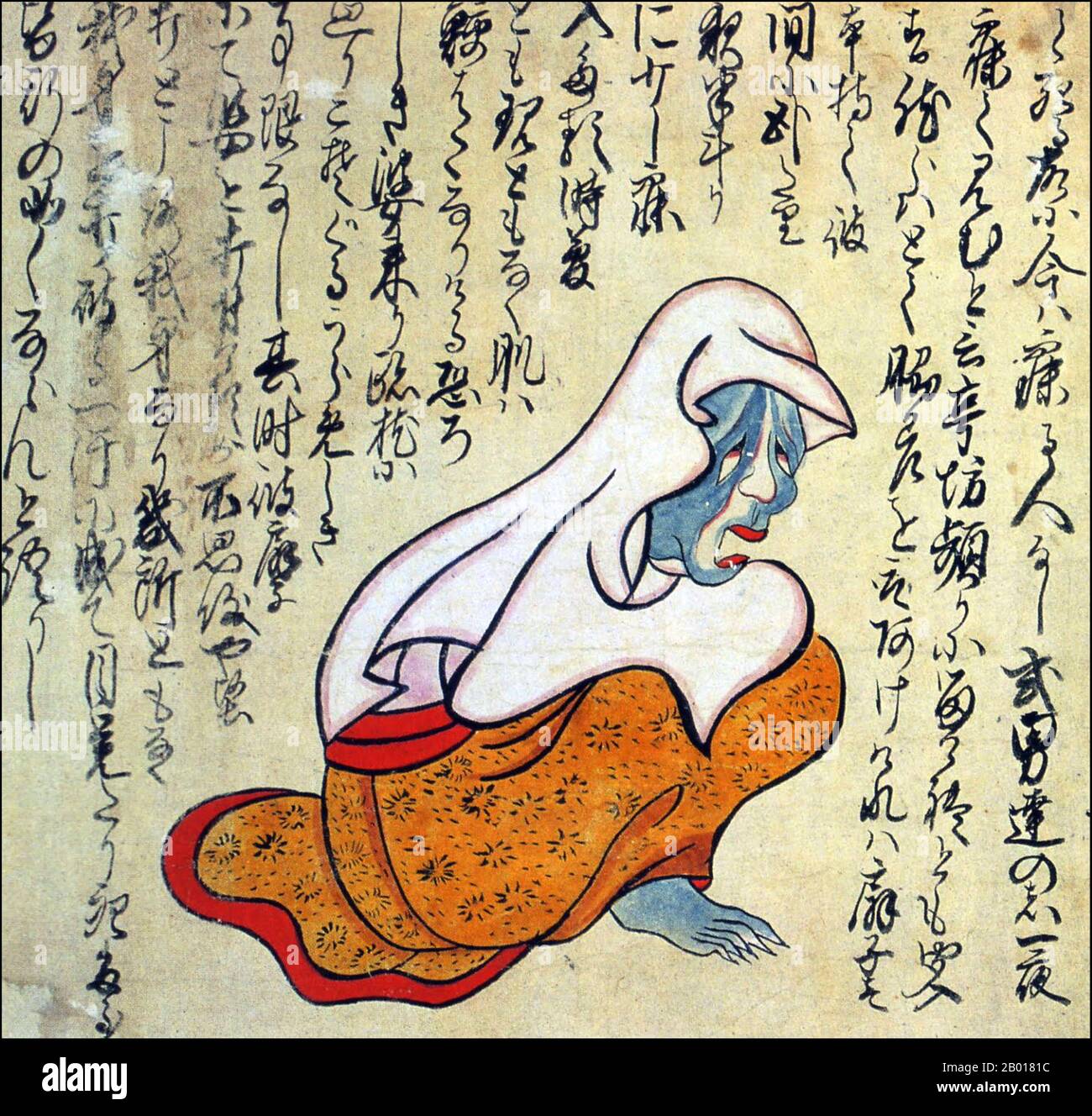 Japan: The ghost of an old woman at a temple in Fukuoka. From the Kaikidan Ekotoba Monster Scroll, mid-19th century.. This illustration depicts a ghostly old woman known to appear late at night in a certain guest room at a temple in the Kaho area of Fukuoka prefecture. On many occasions terrified lodgers ended up fatally wounding themselves after trying to strike her with a sword. The Kaikidan Ekotoba is a mid-19th century handscroll that profiles 33 legendary monsters and human oddities, mostly from the Kyushu region of Japan, but with several from other countries. Stock Photohttps://www.alamy.com/image-license-details/?v=1https://www.alamy.com/japan-the-ghost-of-an-old-woman-at-a-temple-in-fukuoka-from-the-kaikidan-ekotoba-monster-scroll-mid-19th-century-this-illustration-depicts-a-ghostly-old-woman-known-to-appear-late-at-night-in-a-certain-guest-room-at-a-temple-in-the-kaho-area-of-fukuoka-prefecture-on-many-occasions-terrified-lodgers-ended-up-fatally-wounding-themselves-after-trying-to-strike-her-with-a-sword-the-kaikidan-ekotoba-is-a-mid-19th-century-handscroll-that-profiles-33-legendary-monsters-and-human-oddities-mostly-from-the-kyushu-region-of-japan-but-with-several-from-other-countries-image344235624.html
Japan: The ghost of an old woman at a temple in Fukuoka. From the Kaikidan Ekotoba Monster Scroll, mid-19th century.. This illustration depicts a ghostly old woman known to appear late at night in a certain guest room at a temple in the Kaho area of Fukuoka prefecture. On many occasions terrified lodgers ended up fatally wounding themselves after trying to strike her with a sword. The Kaikidan Ekotoba is a mid-19th century handscroll that profiles 33 legendary monsters and human oddities, mostly from the Kyushu region of Japan, but with several from other countries. Stock Photohttps://www.alamy.com/image-license-details/?v=1https://www.alamy.com/japan-the-ghost-of-an-old-woman-at-a-temple-in-fukuoka-from-the-kaikidan-ekotoba-monster-scroll-mid-19th-century-this-illustration-depicts-a-ghostly-old-woman-known-to-appear-late-at-night-in-a-certain-guest-room-at-a-temple-in-the-kaho-area-of-fukuoka-prefecture-on-many-occasions-terrified-lodgers-ended-up-fatally-wounding-themselves-after-trying-to-strike-her-with-a-sword-the-kaikidan-ekotoba-is-a-mid-19th-century-handscroll-that-profiles-33-legendary-monsters-and-human-oddities-mostly-from-the-kyushu-region-of-japan-but-with-several-from-other-countries-image344235624.htmlRM2B0181C–Japan: The ghost of an old woman at a temple in Fukuoka. From the Kaikidan Ekotoba Monster Scroll, mid-19th century.. This illustration depicts a ghostly old woman known to appear late at night in a certain guest room at a temple in the Kaho area of Fukuoka prefecture. On many occasions terrified lodgers ended up fatally wounding themselves after trying to strike her with a sword. The Kaikidan Ekotoba is a mid-19th century handscroll that profiles 33 legendary monsters and human oddities, mostly from the Kyushu region of Japan, but with several from other countries.